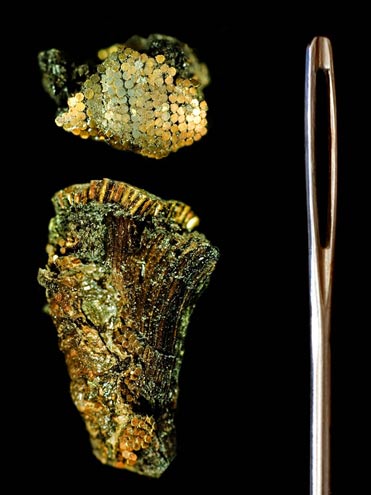Anthropology
Related: About this forumStonehedge fine goldwork compared to sewing needle

Detail of the decoration of the dagger handle, shown next to a sewing needle for scale. The studs were placed in straight lines and the heads overlapped each other like fish scales
The Stonehenge area object with the largest number of ultra-small gold components is a dagger made in around 1900 BC – and now on display in Devizes’ Wiltshire Museum.
Crafted more than 1100 years before the invention of the first magnifying glass, the dagger’s 12 centimetre long handle was adorned with up to 140,000 tiny gold studs – each around a millimetre long and around 0.2 of a millimetre in diameter. Even the heads of each stud are just a third of a millimetre wide.
They were set, with great manual dexterity and remarkable skill, into the surface of the wooden dagger handle - with more than a thousand studs neatly embedded in each square centimetre.

The ancient dagger
more of the story
http://www.independent.co.uk/news/science/archaeology/stonehenges-most-intricate-archaeological-finds-were-probably-made-by-children-9738993.html
CHILD LABOR LAWS WERE NOT IN EFFECT
Judi Lynn
(160,527 posts)20 September, 2014 - 14:26 aprilholloway
Archaeologists reveal astounding Bronze Age microscopic gold work from around Stonehenge
Archaeologists have revealed the process utilized by highly-skilled craftsmen to create the magnificent gold artifacts that were found around Stonehenge. According to Discovery News, the gold work involved such tiny components that optical experts believe they could only have been made by children or adults with extreme short-sightedness, and would have caused lasting damage to their eyesight.
In 1808, William Cunnington, one of Britain's earliest professional archaeologists, discovered what has become known as the crown jewels of the 'King of Stonehenge'. They were found within a large Bronze Age burial mound just ½ mile from Stonehenge, known today as Bush Barrow. Within the 4,000-year-old barrow, Cunnington found ornate jewellery, a gold lozenge that fastened his cloak, and an intricately decorated dagger.
“The very finest gold work involved the making and positioning of literally tens of thousands of tiny individually-made components, each around a millimetre long and around a fifth of a millimetre wide,” said David Dawson, Director of the Wiltshire Museum in Devizes where the micro-gold working achievements are on permanent display.
A report in The Independent explained the amazing process involved in creating the handle of just one dagger, adorned with up to 140,000 tiny gold studs just a third of a millimetre wide. The first stage involved manufacturing extremely fine gold wire, just a little thicker than a human hair. The end of the wire was then flattened to create a stud-head, and was then cut with a very sharp flint or obsidian razor, just a millimetre below the head. This delicate procedure was then repeated literarily tens of thousands of times.
- See more at: http://www.ancient-origins.net/comment/4783#sthash.WTcNBXng.dpuf
[center]~ ~ ~[/center]
Incredible! Thanks for sharing this material. Never would have known if you hadn't! It's helping to flesh out what little we've learned yet about this area. Shocking degree of craftsmanship. What a shame it ruined their eyes!
Ichingcarpenter
(36,988 posts)though a plausible one.
There is also the possibility of the use of 'reading balls' using clear quartz. The early Hindus, Greeks and Romans used small ones as reading balls (magnifiers). ...
http://www.rockhoundingar.com/qtzgems.php
The History of Lapidary
http://www.gemsociety.org/article/the-history-of-lapidary/
Orsino
(37,428 posts)